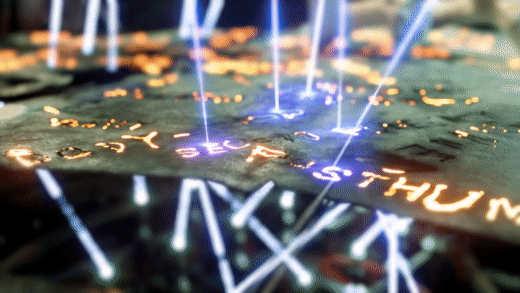Rewriting Humanism:
Arca, Posthumanism, and Gender Acceleration
by Jay Dye
Arca the Posthuman

A clip from Arca's "Prada/Rakata" music video, showing the word "POSTHUMAN" being laser-etched into a surface.
On an Instagram livestream, Arca paused briefly while describing her gender identity in response to a viewer's question. It's "glitch at this point," she said, "like the language is breaking down" ("Arca"). In this moment, she was fighting with the limitations of language, its inability to express her feelings and experience. "I'm not breaking down," she said, "I'm comfortable" ("Arca"). Language was the source of failure here, not herself.
Experiencing the shortcomings of language is a fundamental part of being posthuman. The posthuman recognizes that "[l]anguage is not all of reality, but part of it. The distinctions we make between things in the world, including the one between ourselves and the world, are illusory in as much as they arise through language" (Ascott). Arca recognizes this in this moment; language, a subset of reality, cannot possibly communicate the fullness of real, lived experience. Language cannot capture what it means to be human.
"Does anyone know what it means to be human?" she asks, "like to decide something's human and something isn't?" ("Arca"). This is clearly an important question to Arca, who is constantly exploring altered forms of being. She refers to her fans as "mutants," implying that having a penchant for her art makes one an inherently altered life form. Her recent release, kick iiii, features tracks titled "Xenomorphgirl," referencing the xenomorph alien from Alien, and "Alien Inside," which features a spoken-word poem by Shirley Manson whose speaker tells of having "recognized the alien inside," the "posthuman celestial sparkle / a mutant faith."
It's this embrace of nonhuman identity that sets Arca apart from humanist thinking. This is how she rewrites humanism. In humanist narratives, "definitive versions of what it means to be human emerge from encounters with the refracted 'Other' in the form of the monster, the android, the Doppelganger, or the alien" (Graham 221). By seeing something notably inhuman, the concept of being human is constructed in opposition. They are "gatekeepers between identity and difference—gendered, radicalized, medicalized" beings who draw the line between what is human and what is Other (Graham 227). This is why Frankenstein's monster is called a monster and mistreated; this is why the term "alien" is so problematic in our political discourse today: there is an implication that monsters and aliens are less than human and must be controlled by those who claim absolute humanity.
Arca flips this traditional script on its head. Aliens, cyborgs, and mutants are no longer sidelined as less-than, but instead brought into the spotlight as the primary audience. She is one, too: her music videos and album artwork for the Kick cycle portray her in various forms of Otherness, whether its the satyr-like costume from KiCk i, the two-headed symbol of alchemical conjuction from KicK iii, or even her claiming of nonbinary gender expression in "Nonbinary."

The cover art for all 5 Kick albums
Arca's owning of nonhuman identity is what makes her work posthuman. She doesn't care how you identify or how human you might be; in this space, we're all mutants.
Choose Your Level